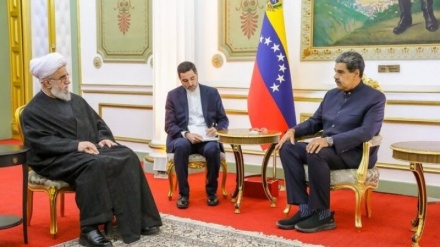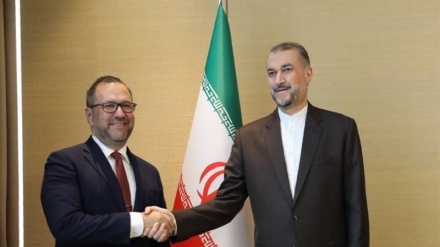NY Times admits US-backed Venezuela opposition caused aid fire
Initial Reports by Alternative Press that the torching of the relief shipped to Venezuela was by elements on the payroll of Washington and not by the government as alleged by the Americans.
In this regard, we present you a report by Chile-based American journalist Whitney Webb for MintPress, titled: “New York Times Admits US-Backed Venezuela Opposition Caused Aid Fire”.
While independent outlets have made headway in challenging US government narratives, such outlets are often maligned by the so-called influential mainstream outlets for reports that question the official story.
The international outrage generated by images of US-donated “humanitarian” aid on fire at a Colombian-Venezuelan border crossing last month inspired a frenzied call for change of government in Venezuela from top US politicians and media outlets once the blaze was promptly blamed on the Venezuelan government led by President Nicolás Maduro.
Many independent journalists and non-mainstream outlets had been more skeptical, while still others provided video evidence that — in fact — Venezuelan opposition protesters, not the Venezuelan military, had been responsible for the fires. Yet, this evidence was ignored by the corporate media, and those opposing the official narrative became “Maduro apologists” in a narrative all too familiar to those who remember previous US-led regime-change efforts abroad.
Now, several weeks later, the narrative has suddenly reversed, following a New York Times investigation that revealed that the fire that consumed the aid trucks had indeed been caused by those backed by the US and called the Venezuelan opposition.
The New York Times on last Sunday published a report that corroborates earlier reports from independent journalists that a Molotov cocktail thrown by a supporter of the US-backed and -funded opposition was ultimately responsible for the blaze.
It cited “unpublished footage” as well as footage that had been previously released by the Colombian government. The report notes that, half a minute before the first truck caught fire, “a homemade bomb made from a bottle is hurled toward the Venezuelan police…the rag used to light the Molotov cocktail separates from the bottle, flying toward the aid truck instead.”
The NY Times then notes that “the same protester can be seen 20 minutes earlier, in a different video, hitting another truck with a Molotov cocktail.”
It is unclear exactly why the New York Times decided to publish this story now, given that footage available over two weeks ago shows the Molotov cocktails being thrown at the aid trucks and the burning rag landing atop one of them. Its report, however, is a rare example of a mainstream US outlet contradicting the official narrative about a government currently being targeted by Washington for regime change.
Dan Cohen of Russian TV tweeted: (US Senator) Marco Rubio’s lie debunked: This video shows an opposition protester throwing a Molotov cocktail at the aid truck on the Francisco de Paula Santander bridge connecting Venezuela and Colombia.
It is obvious that the New York Times is timidly trying to reshape the official narrative by alleging that the fire was accidental, when the video clearly shows repeated deliberate arson attack by US-backed elements.
Despite the fact that claims that Maduro was responsible for the incident have been debunked by the country’s “paper of record,” the US government has declined to walk back from the narrative entirely, though it has notably struck a more “cautious” tone.
One US government statement cited by the New York Times, read: “Eyewitness accounts indicate that the fire started when Maduro’s forces violently blocked the entry of humanitarian assistance.”
Then, Garrett Marquis, a spokesman for the National Security Council claimed in a crude attempt to distort the facts that Maduro is responsible for creating the conditions for violence; his forces denied the entry of tons of food and medicine, while thousands of courageous volunteers sought to safeguard and deliver aid to Venezuelan families.
Marquis failed to explain how hurling Molotov cocktails qualified as “safeguarding” aid supplies.
The New York Times tried to accord these statements credibility, despite the fact that the core claim of the article — that the Venezuelan opposition was responsible for the fire — should greatly reduce their credibility regarding this incident.
There was no mention of the fact that Elliott Abrams, the US envoy for Venezuela, has a history of hiding weapons in humanitarian aid shipments, nor of the fact that the US’ role in the border showdown had been condemned by the Red Cross and the United Nations for “politicizing” humanitarian aid.
The New York Times story also failed to note reporting by Russian TV’s Dan Cohen, who was told by a Colombian government-affiliated priest that the showdown was “designed to induce regime change” and create “a violent clash inside Venezuela.”
Furthermore, the daily also — shockingly — lends credibility to some of those present who were hurling Molotov cocktails at Venezuelan security forces. It writes that “protesters who threw Molotov cocktails from the bridge insisted that Mr. Maduro’s forces, not their homemade bombs, set the fire,” and uncritically offers testimony from violent protesters, one of whom the paper casually introduces as “another bomb thrower.”
In addition, the New York Times entertained claims made by Gaby Arellano, a spokeswoman for the US-backed so-called Venezuelan “president,” Juan Guaidó, who claimed that tear gas canisters thrown by Venezuelan forces were to blame for the fire, despite the fact that tear gas is not incendiary, unlike Molotov cocktails.
It seems likely that the daily gave so much attention to these statements and counter-narratives to prevent itself from straying too far from the official narrative, even to the point that it calls the core thesis of its own report into question.
Indeed, the New York Times has long been a cheerleader of past government lies that were used to manufacture consent for war, including the “weapons of mass destruction” lie that led to the Iraq War. Thus, this latest report is refreshing in the sense that the Times was willing to challenge the prevailing narrative, even if it sought to weaken that challenge as its report went on.
Yet, the Times report also shows the power of such top media outlets in controlling the narrative. While independent outlets have made headway in challenging government narratives, such outlets are often maligned by influential mainstream outlets for reports that question the official story. Yet, as was the case here, when a newspaper like the New York Times later corroborates those independent reports, it becomes an accepted fact and the narrative changes.
If anything, this particular incident shows not only the importance of independent media outlets but the continued role of the top media outlets in determining the course of public opinion, particularly in regard to Washington-brokered regime-change operations abroad.
AS/MG


